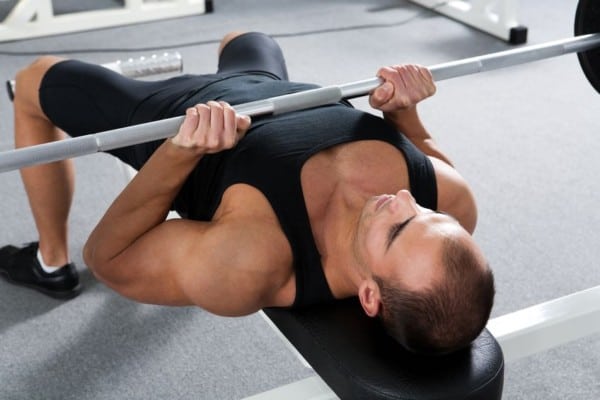There are three types of Grip techniques you can do for the bench press. these three techniques are narrow, medium, and wide. it all depends on your biacromial width. Changing up your grip during a bench press workout can affect performance and possible injury prevention.
Athletes, bodybuilders, and recreational weightlifters should be looking for a grip on the bench press that can help benefit them while preventing injury. When we are doing a bench press we are also looking to increase the greatest Force output that we can. The exercise showed that a wide grip greater than 1.5 biacromial with can possibly raise the risk of causing injuries such as shoulder, anterior shoulder instability, and also their pectoralis major rupture. Reducing grip with less than 1.5 biacromial has been shown to lower the risk up in trees and does not affect the recruitment of muscles.
Let’s look at different width grips for Bench Press
Wide Grip
There isn’t a one size fits all for finding the right grip for bench pressing. A wider grip is better for those who have longer arms. The reason for this is the wider the grip, the lees the bar has to travel. If you have long arms like me and you use a narrow grip, that’s a lot more are you have to cover by bringing the bar down and back up.
Narrow Grip
The exact opposite is true for those with shorter arms, it’s optimal to use more of a shorter grip. Or to say you will naturally have a shorter grip because of your body mechanics.
When we are doing the bench press exercise hand placement and grip is also an over looked part of the technique. The grip width is best to use less then a 1.5 biacromial width.
Your biacromial width is a formula to figure out the distance to place your hands for the bench press. There are acromion bumps on each of your shoulders.
The distance from each is what’s called your biacromial distance. The formula is done by taking your biacromial distance and then multiply it by 1.5, and that is what your ideal bench press grip for your body should be.
When we use an increased grip during the bench press is used or up to roughly 2x’s the amount of your biacromial distance for your shoulder width.
One study showe dthat by using a wide grip bench press could amoint in a 5% increase versus a narrow grip. These exercises were performed on a Smith machine.
A 5% increase isn’t really that much to brag about about when trying to look for performance increase. On the other hand the most single 1-rep bench press was achieved with a wide grip at a 200% biacromial distance. There was a 7% increase on bench press with a wide grip verses a narrow grip.
One reason for thinking is that the wider grip decreases the range of motion during the bench press. The distance the bar has to travel is nearly 25% more with a shoulder-width grip (biacromial distance.)
The wider grip also seems to be more effective with the pectoralis major (pecs) however there is a decrease with triceps. A study in 2005 looked at the difference in activity and found that there was an 18% of pectoral activity while benching at 200% biacromial width than when compared to 100% biacromial width.
| Everyone’s biacromial distance is different which will affect your hand grip width for bench press. Measure the distance from the bony part on top of your shoulders and x by 1.5 to find your biacromial distance. |
Powerlifting grip for Bench Press
I’m not a powerlifter but I thought it would be good for us to look at some of these comparisons for bench press grip. Some coaches recommend a close grip for lifters who are geared.
Geared means they are allowed to use bodysuits or other equipment for weightlifting. When powerlifters use geared shirts it essentially helps with the lower portion of the lift.
A geared powerlifter typically uses the close grip for bench press to help with the pushing range of motion. I don’t know how I really feel about geared weight lifting.
I’ve been around it some and always thought it was cheating. I’ve never done it and will sit on that side of the fence until I ‘m convinced otherwise.
A raw powerlifter is some who doesn’t use any equipment to lift. On the other hand, they will prefer a wide grip bench press vs a narrow. This helps them to build strength in their middle to low portions of the lift.
| Two different type of bench press grips are recommended for each powerlifting style. Geared recommends a narrow grip while raw recommends a wider grip. |
How Power Lifters could lower the chances of Injuries
Doing the right technique and form is always crucial with any kind of lift and I will always preach that instead of overloading the bar up. both type of powerlifters are at a bigger increase for injury than the average weight lifter.
They have a higher then average increase for pectoral tears . This is generally assumed because of the heavy weight they are pushing themselves with.
It’s been shown that a narrow grip may help decrease the chances of a powerlifter tearing their pec muscle. This is because of the narrow grip will decrease the torque cause to these muscles.
| A closer grip style for doing bench press may be bets for powerlifters to prevent injuries and especially pectoral tears. |
Grip width to minimize risk on the bench press
Best steps to prevent or reduce the chances of injury comes form hand grip width. Your grip should be your 1.5 biacromial width to keep your shoulders at an adbuction width at 45 degree.
As you start to bring the barbell down towards your chest it’s been recommended that you should have the bar stop somewhere between 4-6 cm above chest level.
The more narrow the grip width the more of a chance that you could lower the risk by the level of stretch on the pectoralis fibers. This is only really going to affect lifters who are untrained or more of a beginner.
| Preventing injuries can come down to the strength in your shoulders and pec muscle for stabilization. Your grip will play a big role in injury position as most people’s grip will vary depending on arm length. |
Final thoughts
The best bench grip will depend on your own body. Things like shoulder and arm length will determine how wide your grip should be. This should really be taken into consideration when trying to generate as much force and prevent injuries. Finding your biacromial distance is key for everyone. Again, this is done by measure the distance between the two acromion (bony bumps on shoulders) and take that distance and x it by 1.5.

